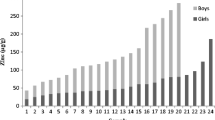Abstract
The aim of this study was to assess the hair copper concentration in a population of healthy children, teenagers, and adults living in a specific region of Poland. For this purpose, 840 healthy individuals aged 1–50 yr living in Szczecin, Poland were selected for the study. They were divided into subgroups according to age and sex and the hair was analyzed for copper using a standard atomic absorption spectrometric technique. The level of copper was highest for the group including 11–15 yr old. In the other subgroups, the concentration of copper was lower than the values considered normal, suggesting the possibility of endemic copper deficiency in the inhabitants of this region.
Similar content being viewed by others
References
D. Strausak, J. F. Mercer, H. H. Dieter, et al., Copper in disorders with neurological symptoms: Alzheimer’s, Menkes, and Wilson diseases, Brain Res. Bull. 55, 175–185 (2001).
J. Lee, J. R. Prohaska, and D. J. Thiele, Essential role for mammalian copper transporter Ctr1 in copper homeostasis and embryonic development, Proc. Natl. Acad. Sci. USA 98, 6842–6847 (2001).
J. F. Mercer, The molecular basis of copper-transport diseases, Trends Mol. Med. 7, 64–69 (2001).
J. Lee, M. M. Pena, Y. Nose, et al., Biochemical characterization of of the human copper transporter Ctr1, J. Biol. Chem. 277, 4380–4387 (2002).
O. Han and M. Wessling-Resnick, Copper repletion enhances apical iron uptake and transsepthelial iron transport by Caco-2 cells, Am. J. Physiol. Gastrointest. Liver Physiol. 3, 527–533 (2002).
R. R. Crichton and J. L. Pierre, Old iron, young copper: from Mars to Venus, Biometals 2, 99–112 (2001).
E. Kleszczewska and T. Kleszczewski, Miedz — zastosowanie, wchlanianie, zapotrzebowanie, interakcje, przeciwwskazania, dzialania niepozdane oraz wlasciwosci i oznaczanie, Biul. Magnezol. 4, 207–216 (1998, in Polish).
E. Kleszczewska, Reakcje witaminy C z wybranymi biopierwiastkami na przykladzie miedzi, rteci i kadmu, Terapia 7, 48–51 (1999).
A. Wachnik, Fizjologiczna rola miedzi i jej znaczenie w zywieniu, Rocz. Panstw. Zakl. Hig. 38, 4 (1987) (in Polish).
S. Ziemlanski, Podstawy Prawidlowego zywienia Czlowieka, PWN, Warszawa (1998) (in Polish).
T. Sakai, M. Wariishi, and K. Nishiyma, Changes in trace element concentrations in hair of growing children, Biol. Trace Element Res. 1, 43–51 (2000).
L. Perrone, M. Salerno, G. Gialanella, et al., Long-term zinc and iron supplementation in children of short stature: effect of growth and on trace element content in tissues, J. Trace Elements Med. Biol. 13(1–2), 51–56 (1999).
J. Skorkowska-Zieleniewska, Biochemiczna ocena stanu odzywienia mineralnego, CzescIII. Cynk i miedz, Przegl. Ped. 2, 104–113 (1987) (in Polish).
K. Miniuk, J. Moniuszko-Jakoniuk, et al., Biodostepnosc oraz stany chorobowe przy niedoborze miedzi, Pol. Tyg. Lek. 24–26, 476–478 (1991) (in Polish).
T. Lech, A. Garlicka, and C. Zych- Litwin, Zawartosc we wlosach wapnia, magnezu, cynku, miedzi i olowiu’w wybranych stanach chorobowych u dzieci, Diagn. Lab. 32, 477–484 (1996) (in Polish).
B. Nowak and J. Chmielnicka, Relationship of lead and cadmium to essential elements in hair, teeth and nails of environmentally exposed people, Ecotoxicol. Environ. Safety 3, 265–274 (2000).
T. Sakai, M. Warrishi, and K. Nishiyama, Changes in trace element concentrations in hair of growing children, Biol. Trace Element Res. 1, 43–51 (2000).
A. Bertazzo, C. Costa, M. Biasiolo, et al., Determination of copper and zinc levels in human hair: influence of sex, age, and hair pigmentation, Biol. Trace Element Res. 1, 37–53 (1996).
K. Radomska, A. Graczyk, and J. Konarski, Contents of macro-and microelements in human body determined by hair analysis, populational studies, Clin. Chem. Enzyme Commun. 5, 105–118 (1993).
Q. Feng, Y. Suzuki, and A. Hisashiga, Trace elements contents in hair of residents from Harbin (China), Medan (Indonesia) and Tokushima (Japan), Biol. Trace Element Res. 1–3, 75–86 (1997).
S. C. Foo and T. C. Tan, Elements in the hair of Southeast Asian islanders, Sci. Total Environ. 2–3, 185–192 (1998).
T. Paszkowski and R. Sikorski, Przydatnosc wlosów ludzkich w badaniach metabolizmu metali sladowych, Wiad. Lek. 40, 132 (1987) (in Polish).
A. Gordus, Human hair as an indicator of trace metal environmental exposure, Trace Contamination Conference (1973).
J. Kasznia-Kocot, Z. Zachwieja, J. Chlopicka, et al., Zawartosc wybranych mikroelementów i metali ciezkich we wlosach dzieci z Chorzowa, Ped. Pol. 31–36 (1996) (in Polish).
Z. Zachiweja, M. Szlegel-Zawadzka, J. Chlopicka, et al., The comparison of the copper content in the hair of children living in several cities in Southern Poland, Trace Elements Man Anim. 8, 1087–1090 (1993).
I. Hornowska, Wplyw wybranych hormonów na zawartosc niektórych biopierwiastków u dziewczat w okresie dojrzewania, Praca doktorska, Poland, Szczecin (1995) (in Polish).
W. Zaborowska and J. Wiercinski, Oznaczanie olowiu, kadmu, miedzi i cynku we wlosach dzieci Lublina jako próba oceny zanieczyszczenia srodowiska, Rocz. PZH 2, 217–222 (1996) (in Polish).
K. Pasternak, B. and Florianczyk, Metale zycia. Wybrane metale i ich rola w funkcjonowaniu organizmu czlowieka, Wydanie I, Folium, Lublin (1995) (in Polish)
Author information
Authors and Affiliations
Rights and permissions
About this article
Cite this article
Kozielec, T., Pózniak, J., Salacka, A. et al. Hair copper concentration in healthy children, teenagers, and adults living in Szczecin, Poland. Biol Trace Elem Res 93, 47–53 (2003). https://doi.org/10.1385/BTER:93:1-3:47
Received:
Revised:
Accepted:
Issue Date:
DOI: https://doi.org/10.1385/BTER:93:1-3:47




